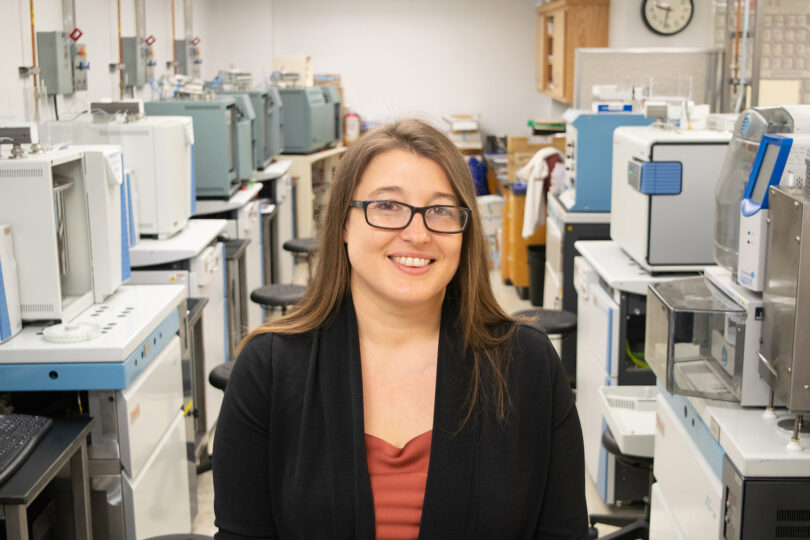UGA’s Center for Applied Isotope Studies has a new director. Carla Hadden was appointed to lead the isotope geochemistry lab—the largest in the United States and possibly the world—effective May 15.
Established in 1977, CAIS employs more than 30 research scientists, technicians and graduate students who specialize in disciplines ranging from archaeology and geology to marine science and environmental toxicology. The center houses several facilities that offer a range of analytical services, such as authenticating food ingredients for industry clients, dating historic art pieces and archaeological artifacts, and analyzing water runoff for metal and chemical compounds.
“The Center for Applied Isotope Studies has earned a global reputation for its work supporting research in a wide range of disciplines, and its activity in stable isotope analysis for outside companies and scientists has grown tremendously in recent years,” said Karen Burg, vice president for research. “Dr. Carla Hadden has both the experience and the acumen to lead CAIS into its next phase of growth.”
Hadden received her bachelor’s degrees in zoology and anthropology from the University of Florida and her Ph.D. in anthropology from UGA. She has co-authored more than 20 peer-reviewed publications and book chapters and has led archaeological research projects funded by the National Science Foundation and the U.S. Department of the Interior. Prior to becoming director of CAIS, Hadden served as interim assistant director, but her involvement goes back even further, starting when she was a graduate student volunteering at the center.
“Once I started working here as a grad student, I just didn’t want to leave,” said Hadden.
Those who have been on a Zoom call with Hadden in the past year may have noticed that her profile picture is of a Lego scientist with a beaker in one hand and bone in the other—a geochemist who works across disciplines like Hadden herself. Originally trained in zooarchaeology, the study of archaeological animal remains, Hadden became interested in radiocarbon dating and geochemical studies of bones, shells and other archaeological artifacts in graduate school and was drawn to the interdisciplinary research conducted at CAIS.
“What I really enjoy about being at CAIS in general is having the opportunity to interact with all these really unique, interesting people with different backgrounds, skill sets and expertise, and finding new ways for our interests to align and new opportunities for interdisciplinary research,” she said.
On average, CAIS analyzes approximately 6,000 samples for radiocarbon dating and 6,000 samples for food and flavoring authentication each year, generating about $3 million in revenue from these services alone. Hadden credits the center’s dedicated staff for being able to keep up with the increasing demand.
Part of the center’s rapid growth was a result of becoming more involved with other units on campus in terms of research collaborations and undergrad and graduate education in recent years.
“Seeing that trajectory continue is something that is really important to me. I want to see us more involved in education, more involved in teaching students how to apply isotope studies to a number of different fields,” said Hadden.
One of the center’s many outreach initiatives include the publication of comic books that teach the public about applications of radiocarbon dating drawing from real-life projects conducted at CAIS. The comic books have been distributed to K-12 classrooms, as well as handed out at scientific and academic conferences. The center is working on its next comic book, about an NSF project Hadden is heading with collaborators to study how the early cattle industry in Colonial Carolina’s lowcountry changed its ecosystem and landscapes.
Hadden also looks forward to leading the center in acquiring more high-end instruments and helping researchers take advantage of currently available resources to conduct innovative research. “I want our scientists to be more involved in pushing the limits of what’s possible with the different methods and tools we have available to us.”








